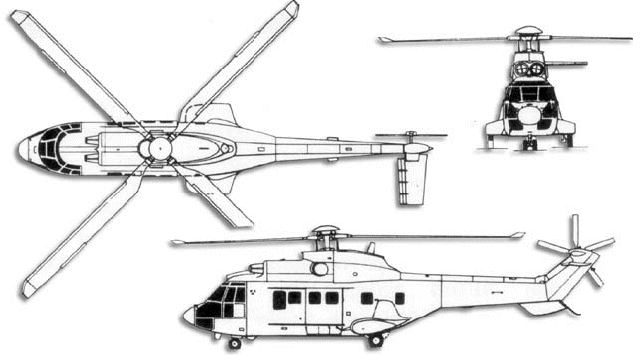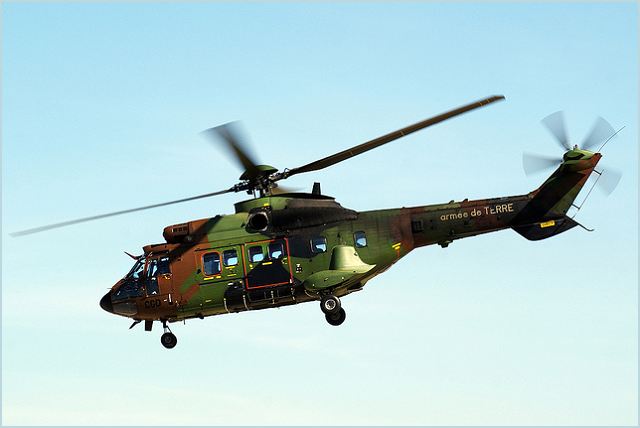SA332 Super Puma Eurocopter H215
| a | ||||||||||||||||||||||
|
SA 332 AS 332 Super Puma Tactical transport helicopter
|
||||||||||||||||||||||
|
|
||||||||||||||||||||||
|
|
||||||||||||||||||||||
|
The Eurocopter AS332 Super Puma is a four-bladed, twin-engine, medium-size utility helicopter marketed for both civil and military use. This helicopter was originally designed and manufactured by the French Company Aérospatiale. The Aerospatiale SA 332 Super Puma is a development of the S A 330 Puma with more powerful Turbomeca Makila turboshafts, multipurpose air intakes, lightweight Starflex rotor head with uprated transmission and thermically de-iced main rotor blades, and wider-track landing gear with single wheels. Most of these features have already been test-flown on modified SA 330 Pumas, and a fully representative SA 332 Super Puma prototype first flew on 13 September 1978. Production of this new version was commenced in August 1978, with the first completed SA 332C civil example delivered (to Petroleum Helicopters) in 1981. In its initial commercial form, the SA 332 Super Puma has the same capacity as the SA 330 (two crew plus 19 passengers) but markedly superior performance. Yet greater capability is offered by the 'stretched' version, the SA 332L Super Puma, the prototype of which first flew on 10 October 1980. Compared with the basic SA 332 Super Puma, the SA 332L has its fuselage lengthened by 0.76 m in, and an extra window has been added on each side of the forward fuselage. The 'stretch' increases passenger capacity to 24, and the increased payload with the same fuel capacity initially meant reduced payload/range performance. However, Aerospatiale has now developed swept-back tips for the rotor-blade tips, and this permits an initial increase in maximum take-off weight of 200 kg, with another increase of 200 kg to be certificated later. The effect of this weight increase is to boost the range performance of the SA 332L to a figure closely comparable to that of the SA 332. |
||||||||||||||||||||||
| Main Variants | ||||||||||||||||||||||
|
- SA 332 Super Puma: development aircraft
- SA 332C Super Puma: initial civil production version - SA 332L Super Puma: stretched version - SA 332M Super Puma: initial military production version, capable of carrying a slung load of 4000 kg in the transport role, or two Exocet ASMs in the anti-shipping role. - AS532 AL+: troop and load transportation, complex search and rescue (SAR), combat SAR missions as well as casualty evacuation - AS332 L1e: from passenger transportation, executive transportation to SAR - AS332 C1e: aerial work such as heavy sling, logging, power line maintenance. |
||||||||||||||||||||||
| Technical Data | ||||||||||||||||||||||
| Design | ||||||||||||||||||||||
|
The SA 332 Super Puma was designed to withstand damage better, with a more robust fuselage structure, a new crashworthy undercarriage and the ability to withstand battle damage to the rotor blades and other key mechanical systems. He is with a ventral fin under the tail a more streamlined nose compared with the SA 330, while from the start was planned to be available with two fuselage lengths, with a short fuselage version offering similar capacity to the SA 330, which gives better performance in "hot and high" conditions and a stretched version allowing more passengers to be carried when weight is less critical.
|
||||||||||||||||||||||
| Avionic and defence systems | ||||||||||||||||||||||
|
SA 332 Super Puma is equipped with full glass cockpit avionics and the latest generation autopilot including 2 display and autopilot control panels, 1 Integrated Standby Instrument System (ISIS) for airspeed, altimeter and gyro-horizon back-up display, 1 redundant Vehicle Monitoring System (VMS) with one redundant Aircraft Management Computer (AMC) and two 4" x 5" LCD displays. Additionally, the Super Pumas can be equipped with an advanced avionics cockpit. These enhancements include Global Positioning System / Wide Area Augmentation System (GPS/WAAS) navigation capability, instrument flight rules (IFR) capability, and weather RADAR. Super Puma and flight crews will be capable of flight in nearly all weather conditions, enabling a trauma patient on board to reach a hospital emergency room when all other less capably equipped helicopters will be stuck on the ground. For enhanced safety, Super Pumas can be also equipped with Enhanced Ground Proximity Warning System / Terrain Awareness and Warning System (EGPWS/TAWS), and a program Flight Operational Quality Assurance (FOQA) program.
|
||||||||||||||||||||||
| Propulsion | ||||||||||||||||||||||
|
The SA 332 Super Puma is powered by two 1325kW Turboméca Makila turboshafts driving a four blade main rotor and five blade tail rotor. AS 332L2 - Two 1375kW (1845shp) takeoff rated Turboméca Makila 1A2 turboshafts.Super Puma is equipped with one fuel system of 2,020 litres usable capacity comprising 6 tanks, arranged in 2 groups, 4 booster pumps, 1 transfer pump and a low/high fuel level warning system. The pipes are of the crashworthy type. Engine air intakes are protected against icing by grids and heating mats on the air intake stub frames.
|
||||||||||||||||||||||
| Armament | ||||||||||||||||||||||
|
SA 332 Super Puma can be equipped with a broad range of armaments including 7.62mm general purpose cabin-door machine guns (on pintle mountings), 7.62mm gun pods, rocket pods, anti-ship missiles and various makes of air-to-surface missiles
|
||||||||||||||||||||||
| Specifications | ||||||||||||||||||||||
|
||||||||||||||||||||||
 |
||||||||||||||||||||||
|
||||||||||||||||||||||
































